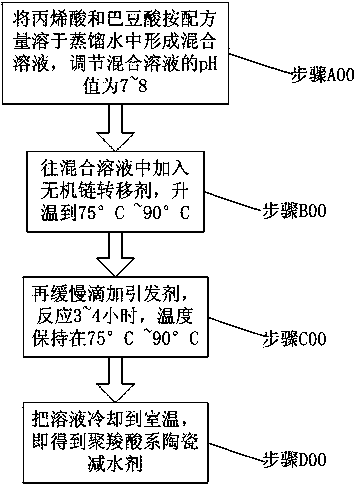Polycarboxylate-based ceramic water reducer and preparation method as well as application thereof
A ceramic water-reducing agent and a polycarboxylic acid-based technology, which is applied in the field of ceramic water-reducing agent preparation, can solve the problems of limited use of inorganic water-reducing agents, large addition amount, and increased production cost of composite water-reducing agents, thereby reducing the Viscosity, improve fluidity, good water reduction effect
- Summary
- Abstract
- Description
- Claims
- Application Information
AI Technical Summary
Problems solved by technology
Method used
Image
Examples
preparation example Construction
[0030] Such as figure 1 Shown is a flow chart of the steps of the preparation method of the polycarboxylate ceramic water reducer in the present invention. A preparation method of the polycarboxylate ceramic water reducer as described above, specifically comprising the following steps:
[0031] Step A00: dissolving acrylic acid and crotonic acid in distilled water according to the formula to form a mixed solution, and adjusting the pH value of the mixed solution to 7-8;
[0032] Step B00: Add an inorganic chain transfer agent to the mixed solution, and heat up to 75 ° C ~ 90 ° C;
[0033] Step C00: Slowly add the initiator dropwise, react for 3 to 4 hours, and keep the temperature at 75°C to 90°C;
[0034] Step D00: Cool the solution to room temperature to obtain a polycarboxylate ceramic water reducer.
[0035] In this embodiment, in the step A00, adjusting the pH value of the mixed solution to 7-8 is realized by adding sodium hydroxide solution to the mixed solution, and ...
Embodiment 1
[0039] Step A00: Add 80 g of acrylic acid, 30 g of crotonic acid, and 120 g of distilled water into a three-necked flask with a stirrer, stir to form a mixed solution, and dropwise add a mass fraction of 60% sodium hydroxide solution to adjust the pH of the mixed solution to 8; Step B00: Add 5.5 g of inorganic chain transfer agent sodium bisulfite to the mixed solution, and heat up to 65 ° C; Step C00: Slowly add 3.4 g of initiator ammonium persulfate, react for 3 hours, and keep the temperature at 65 °C; °C; Step D00: Cool the solution to room temperature to obtain a polycarboxylate ceramic water reducer.
[0040] The performance test of the polycarboxylate-based ceramic water-reducer prepared above was carried out: the test results showed that when adding a polymer water-reducer accounting for 0.15% of the mass fraction of clay, the viscosity of the slurry system was measured to be 715 mPa·s. The initial flow time of the slurry was 52s, and the flow performance was good; the...
Embodiment 2
[0042] Step A00: Add 90 g of acrylic acid, 20 g of crotonic acid, and 100 g of distilled water into a three-necked flask with a stirrer, stir to form a mixed solution, and dropwise add a 60% mass fraction of sodium hydroxide solution to adjust the pH of the mixed solution to 8; Step B00: Add 7.8g of inorganic chain transfer agent sodium bisulfite to the mixed solution, and heat up to 65°C; Step C00: Slowly add 5.6g of initiator ammonium persulfate, react for 3.5 hours, and keep the temperature at 65°C °C; Step D00: Cool the solution to room temperature to obtain a polycarboxylate ceramic water reducer.
[0043] The performance test of the polycarboxylate-based ceramic water-reducer prepared above was carried out: the test results showed that when adding a polymer water-reducer accounting for 0.2% by mass of clay, the viscosity of the slurry system was measured to be 800 mPa·s, The initial flow time of the slurry was 56s, and the flow performance was good; the slurry did not se...
PUM
 Login to View More
Login to View More Abstract
Description
Claims
Application Information
 Login to View More
Login to View More - R&D
- Intellectual Property
- Life Sciences
- Materials
- Tech Scout
- Unparalleled Data Quality
- Higher Quality Content
- 60% Fewer Hallucinations
Browse by: Latest US Patents, China's latest patents, Technical Efficacy Thesaurus, Application Domain, Technology Topic, Popular Technical Reports.
© 2025 PatSnap. All rights reserved.Legal|Privacy policy|Modern Slavery Act Transparency Statement|Sitemap|About US| Contact US: help@patsnap.com

